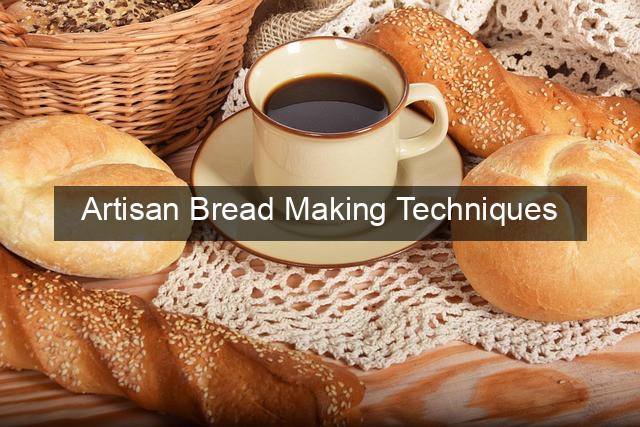Artisan Bread Making Techniques
- Artisan Bread Making Techniques
- The Art of Artisan Bread Making: A Journey into Flavor and Texture
- Understanding the Fundamentals of Artisan Bread
- The Importance of Ingredients
- The Magic of Fermentation
- Kneading and Shaping Techniques
- Baking and Enjoying Your Artisan Bread
- Understanding Your Oven
- Serving and Storing Your Bread
- Exploring Different Types of Artisan Breads
- Sourdough Bread
- Rye Bread
- Whole Wheat Bread
- Conclusion

The Art of Artisan Bread Making: A Journey into Flavor and Texture
Artisan bread making is more than just a culinary skill; it’s a sensory experience. From the satisfying knead of the dough to the intoxicating aroma filling your kitchen, every step is a testament to the craft. This journey transcends simple baking; it’s about understanding the interplay of ingredients, time, and technique to create a loaf that is both nourishing and deeply satisfying. Unlike mass-produced bread, artisan bread emphasizes quality ingredients, traditional methods, and a slow fermentation process. This dedication to detail results in a complex flavor profile, a delightful crust, and a texture that is both chewy and airy. Join us as we delve into the world of artisan bread making, exploring the techniques that transform simple flour and water into a masterpiece.
Understanding the Fundamentals of Artisan Bread
The Importance of Ingredients
High-quality ingredients are the cornerstone of exceptional artisan bread. Flour, the foundation of any loaf, should be chosen with care. Strong bread flour, with its high protein content, is ideal for developing gluten, the network of proteins that gives bread its structure. Water, another crucial element, hydrates the flour and activates the yeast. The type of water can also influence the final product; some bakers even prefer filtered or spring water for its purity. Finally, yeast, the leavening agent, is responsible for the bread’s rise and contributes to its flavor.
Different types of flour, such as whole wheat, rye, or spelt, can add unique flavors and textures to your bread. Experimenting with various flours can open up a world of possibilities. Similarly, the choice of yeast can impact the final product. Active dry yeast is a common choice, while instant yeast offers convenience. Sourdough starters, a culture of wild yeasts and bacteria, add a tangy complexity and depth of flavor that is unmatched.
Salt, while often overlooked, plays a crucial role in bread making. It not only enhances the flavor but also controls the fermentation process and strengthens the gluten structure. The right amount of salt is essential for a well-balanced loaf.
The Magic of Fermentation
Fermentation is the heart and soul of artisan bread making. This process, driven by yeast, transforms the simple dough into a complex and flavorful creation. During fermentation, the yeast consumes the sugars in the flour, producing carbon dioxide gas, which causes the dough to rise. This process also develops a wide array of flavor compounds, contributing to the bread’s characteristic taste.
The length of fermentation can significantly impact the final product. Longer fermentation times, often employed in artisan bread making, result in a more complex flavor profile and a better texture. This slow and steady approach allows the flavors to fully develop and creates a more digestible loaf.
Temperature plays a vital role in fermentation. A warm environment encourages yeast activity, while a cooler environment slows it down. Controlling the temperature allows bakers to manage the fermentation process and achieve the desired results.
Kneading and Shaping Techniques
Kneading is a critical step in developing the gluten structure of the dough. This process strengthens the gluten strands, creating a network that traps the gases produced during fermentation, giving the bread its rise and texture. Proper kneading is essential for a well-structured loaf.
Different bread types require different kneading techniques. Some doughs benefit from a vigorous knead, while others require a gentler approach. Understanding the specific needs of each dough is crucial for success.
Shaping the dough is an art in itself. From simple boules to intricate braids, the shape of the bread not only affects its appearance but also its baking characteristics. Proper shaping ensures even baking and contributes to the overall aesthetic of the finished loaf.
Baking and Enjoying Your Artisan Bread
Understanding Your Oven
Baking artisan bread requires an understanding of your oven’s nuances. Every oven is different, and knowing its hot spots and temperature variations is crucial for achieving consistent results. Using an oven thermometer can help you accurately gauge the temperature and ensure proper baking.
Creating steam in the oven is a common technique used to enhance the crust of artisan bread. Steam helps to keep the surface of the dough moist during the initial stages of baking, allowing for better oven spring and a crispier crust.
Baking times and temperatures vary depending on the type of bread and the size of the loaf. Following a recipe closely and paying attention to visual cues, such as the color of the crust, are essential for determining when the bread is done.
Serving and Storing Your Bread
Once baked, artisan bread is best enjoyed fresh. The crust, crisp and crackling, and the crumb, soft and airy, are at their peak immediately after baking. Slicing and serving the bread while it’s still slightly warm enhances the sensory experience.
Proper storage is essential for maintaining the quality of your artisan bread. Storing the bread in a breadbox or a paper bag can help to preserve its freshness. Freezing bread is also an option for extending its shelf life.
Artisan bread can be enjoyed in countless ways. From simple toast with butter to elaborate sandwiches and bruschetta, the possibilities are endless. The rich flavor and texture of artisan bread elevate any meal.
Exploring Different Types of Artisan Breads
Sourdough Bread
Sourdough bread, known for its tangy flavor and chewy texture, is a testament to the power of natural leavening. The sourdough starter, a culture of wild yeasts and bacteria, is the heart of this bread. It imparts a unique flavor profile and contributes to the bread’s characteristic open crumb.
Making sourdough bread requires patience and dedication. The starter needs to be nurtured and maintained, and the fermentation process can take several hours, or even days. However, the reward is a loaf of bread that is both complex and satisfying.
There are numerous variations of sourdough bread, each with its own unique characteristics. From rye sourdough to whole wheat sourdough, exploring different flours and techniques can lead to exciting discoveries.
Rye Bread
Rye bread, with its distinctive earthy flavor and dense texture, is a staple in many cultures. Rye flour, often combined with wheat flour, gives this bread its characteristic color and flavor. Rye bread can range from light and airy to dark and dense, depending on the proportion of rye flour used.
Rye bread offers a versatile base for sandwiches and can also be enjoyed with cheese, cured meats, or simply with butter. Its robust flavor pairs well with strong flavors.
Different types of rye bread, such as pumpernickel, are known for their intense flavor and dark color. Exploring the world of rye bread can be a rewarding culinary adventure.
Whole Wheat Bread
Whole wheat bread, made with whole wheat flour, offers a nutritional boost and a nutty flavor. The whole wheat flour retains the bran and germ of the wheat kernel, providing more fiber and nutrients than refined white flour.
Whole wheat bread can sometimes be denser than white bread, but proper kneading and fermentation techniques can result in a loaf that is both nutritious and enjoyable.
Experimenting with different whole wheat flours, such as hard red winter wheat or soft white wheat, can yield interesting variations in flavor and texture.
| Bread Type | Flour | Leavening Agent | Baking Time |
|---|---|---|---|
| Sourdough | Strong Bread Flour, Rye Flour | Sourdough Starter | 45-60 minutes |
| Rye | Rye Flour, Bread Flour | Yeast | 30-45 minutes |
| Whole Wheat | Whole Wheat Flour | Yeast | 35-50 minutes |
Conclusion
Artisan bread making is a rewarding journey that connects us to the roots of baking. By understanding the fundamentals of ingredients, fermentation, and technique, we can create loaves of bread that are not only delicious but also nourishing and deeply satisfying. From the simple pleasure of kneading dough to the intoxicating aroma of freshly baked bread, the process is a testament to the craft. Embrace the art of artisan bread making and discover the joy of creating something truly special.




